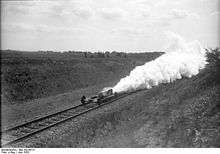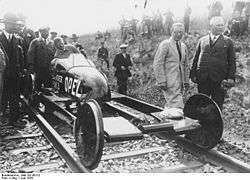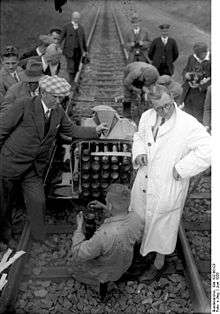Opel-RAK
Opel-RAK were a series of rocket vehicles produced by German automobile manufacturer Fritz von Opel,[1] of the Opel car company, in association with others, including Max Valier and Friedrich Wilhelm Sander largely as publicity stunts.[2] The Lippisch Ente (meaning “duck” in German) a rocket-powered glider was produced on June 11, 1928,[3] piloted by Fritz Stamer at Wasserkuppe,[4] but is not usually considered part of the series.
- Opel RAK.1 - a rocket car that achieved 75 km/h (47 mph) on March 15, 1928[5]
- Opel RAK.2 - rocket car May 23, 1928 reached a speed of 230 km/h (143 mph) driven by 24 solid-fuel rockets[5]
- Opel RAK.3 rocket rail vehicle (quoted speed is variously 254 or 290 km/h.[6][7][8][9][2]) On the second run the vehicle jumps the track and is destroyed.
- Opel Rak IV rocket rail vehicle, destroyed when a solid rocket explodes on the track, exploding all the other rockets. Railway authorities prohibit further runs.[9]
- Opel RAK.1 rocket glider September 30, 1929

 Rocket rail vehicle Opel-Sander Rak.3 in June 1928 | |
| Country of origin | German |
|---|---|
| Designer | Fritz von Opel |
| rocket vehicles | |

In 1928, Fritz von Opel tested his Opel-Rak 1, a converted racing car equipped with Sander rockets instead of an internal combustion engine, was the first rocket powered automobile.[10] On May 23, 1928, Opel himself demonstrated the car, Opel Rak II, on the Avus Speedway near Berlin.[11] Opel RAK 3, built in Germany in the 1920s and campaigned by Opel and Max Valier.[12]
Film footage
The 1937 German film Weltraum Schiff I Startet Eine Technische Fantasie has short clips of various RAK vehicles: 11 seconds at 436 feet (approximately 04:47) igniters being wired to the Rak.2 car; 2 seconds at 447 feet (approximately 04:58) Max Valier seated in a RAK.2 car labeled "RÜCKSTOSS VERSUCHS WAGEN"; 2 seconds at 451 feet (approximately 05:00) Fritz von Opel seated in a RAK.2 car; 11 seconds at 460 feet (approximately 05:06) Fritz Von Opel drives the RAK.2 car on 1928 May 23 at the Avus Track in Berlin; 2 seconds at 472 feet (05:14) Sander-Opel RAK.3 rocket car on 1928 June 23 running on railway tracks; 19 seconds at 475 feet (05:16 to 05:35) Opel-Sander RAK.1 rocket glider in 1928 September, preparation and launch; 6 seconds at 536 feet (05:57 to 06:03) Max Valier sitting and talking in a RAK.6 car.[13]
References
- Keith Lovegrove (2004). Railroad. Laurence King Publishing. pp. 59–. ISBN 978-1-85669-407-0.
- Darling, David. "Opel-RAK". www.daviddarling.info.
- Amy Shira Teitel (22 October 2015). Breaking the Chains of Gravity: The Story of Spaceflight before NASA. Bloomsbury Publishing. pp. 12–. ISBN 978-1-4729-1119-3.
- David Masters (1982). German Jet Genesis. Jane's.
- "OPEL ROCKET VEHICLES".
- "Lux's type collection - High Speed Trains - record runs". www.boris-lux.de.
- "Historie". August 14, 2007. Archived from the original on August 14, 2007.
- "Valier". January 15, 2006. Archived from the original on January 15, 2006.
- "Encyclopedia Astronautica Index: 1". www.astronautix.com.
- The V2 and the German, Russian and American Rocket Program. German Canadian Museum of. pp. 7–. ISBN 978-1-894643-05-4.
- Willy Ley (1961). Rockets, missiles, and space travel. Viking Press.
- Cole Coonce (2002). Infinity Over Zero: Meditations on Maximum Velocity. Kerosene Bomb Publishing. pp. 45–. ISBN 978-0-9719977-0-7.
- Kutter, Anton (1937). "Space Ship Takeoff, a Technical Fantasy (1928)". Bavaria Film Kunst. Retrieved 9 January 2011.
| Wikimedia Commons has media related to Opel-RAK. |
